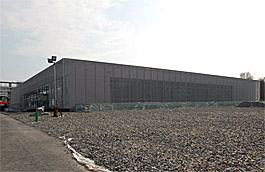
In Berlin, the Topography of Terror has opened
 |
The previous open-air exhibition, showcasing the main architects of Nazi evil, has moved a few dozen meters into the interior of a modern building made of concrete, glass, and steel. It stands on the site of the former main headquarters of the notoriously infamous Nazi secret police, the Gestapo, and SS units.
"No other place is as closely associated with the crimes of Nazism as this one," reminded Köhler during the ceremonial act. He deems the confrontation with these crimes essential for realizing how precarious freedom, human dignity, tolerance, and democracy are. "It is all the more important to preserve awareness of the special historical responsibility of Germans in the future," added Köhler.
"We have a responsibility to ensure that something like this never happens again – neither in Germany, nor in Europe, nor in the world," added Wowereit.
"We have newly conceptualized the exhibition and divided it into three main themes: the history of Nazi terror, the history of this place, and the impact of Nazi terror on the entire city," Nachama explained to journalists shortly before the center's opening.
Visitors will thus be able to familiarize themselves with the appearance of central Berlin during the Third Reich or with Nazi reprisals in countries occupied by Germany during World War II. One of the panels also focuses on the Protectorate of Bohemia and Moravia and reminds with photographs of the massacre of Lidice or the Pankrác prison, where Nazis interned and tortured arrested Czechs.
"The Topography of Terror is not conceived as a memorial, but as a place of learning," emphasized Nachama, who also heads the namesake foundation that financed the project. In addition to the permanent exhibition, seminars on the Nazi regime will be held here, and the local library will offer over 25,000 specialized titles on the same topic, while short-term exhibitions will regularly rotate. The first one will focus on one of the brains behind the Holocaust, Adolf Eichmann, whose capture will mark its 50th anniversary next week.
The aim of knowledge is not only served by the building, shaped like a gray cube with an area of 800 square meters, but also by its deliberately inhospitable surroundings. In the ditch along the remnants of the Berlin Wall, where the original exhibition stood, an exhibition dedicated to the history of Berlin from 1933 to 1945 will be created. The dark history of this place near the Potsdamer Platz, where the Gestapo interrogated and imprisoned an estimated 15,000 people, will also be commemorated by other points on the outdoor grounds.
In the post-war era, these grounds were a gravel dump and later a car track. In 1987, a six-month exhibition on Nazi terror in Germany was opened here, but its response was so great that it became permanent. Discussions about the construction of a museum began back then. However, Berliners had to wait another 23 years for it.
A public competition in the 90s led to the selection of architect Peter Zumthor's design as the winner, but as costs gradually grew to an astronomical 60 million euros (over 1.5 billion CZK today), the Swiss project was canceled and a new competition was announced, in which the proposal by architect Ursula Wilms won four years ago and will open to the public from Friday. Its construction cost the foundation 26 million euros (677 million CZK).
"This documentation center should not be the end but the beginning of our work," believes Nachama, hoping to maintain the visitor numbers that the previous exhibition had. It was viewed on average by half a million people per year, mostly foreign tourists, placing it among the top ten most visited sites in Berlin. Admission to the Topography of Terror will remain free.
The English translation is powered by AI tool. Switch to Czech to view the original text source.
0 comments
add comment












